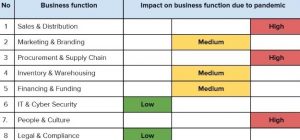The Coronavirus Pandemic abruptly paused the working of MSMEs, which led to the temporarily shutting down their business until things came back on track. MSMEs are called the pillars of the Indian economy due to their vast employment rate and because they manufacture a vast amount of products. Risk Management is a useful process that MSMEs can adopt to improve their chances of sustained and successful longevity.
Yet, they have their own set of problems that they face and during the pandemic, many functions of these businesses were at risk owing to different factors. In this section, the functions which were at risk during the pandemic are listed explaining the areas which were affected.
The location of the business plays an important role in determining its performance. According to the ‘Ministry of MSME Annual Report (FY 19-20)’, 45% of these businesses were based in rural areas while the rest 55% were in urban areas. This gap was lowered in the next FY, increasing the share of rural areas by 4%. This gap has been bridged because the government has worked to lower the inequalities between the geographical areas in terms of economic imbalance. MSMEs curbed the problem of unemployment in rural areas, which in turn would lessen the overpopulation problem in metro cities. This situation has also proven good because the spread of the virus in densely populated metropolitan cities was much faster when compared to the well-distributed rural areas.
1. Sales & Distribution
One major function which was affected due to the lockdown was sales and distribution. As everything shut down, there was instantly no demand for goods and hence, there was no generation of sales. The businesses struggled to stay afloat due to a decrease in demand and were unable to maintain old channel partners. They lost their key clients and were not able to fund their day-to-day operations. Sales and distribution have been one of the most vulnerable functions for these businesses.
According to a survey conducted by the ‘All India Manufacturers Organisation (AIMO)’, 71% of the businesses were not able to pay their employees during the lockdown period. These MSMEs were also overwhelmed due to their dependency on orders from large corporations and government and due to the unavailability of funds and projects going on hold. This dependency resulted in the risk of developing new sales and distribution channels which incurred additional costs. It was noticed that the businesses whose sales were at risk due to the pandemic were so adversely affected that they almost choked to the point of a long time closure.
2. Branding & Marketing
Brand awareness and constant marketing initiatives were also a huge problem for MSMEs during the pandemic. Marketing is an important function for these businesses for promoting sales, but since everything was closed, they faced the challenge of reaching out to their old customers. The incompetence of these businesses to maintain requisite customer engagement led to the risk of losing existing customers. These businesses soon realized the importance of having a digital presence, be it in the form of a personal website, social media channels or global e-commerce channels. India is among the fastest developing markets for digital users. The growing use of digital media has given MSMEs a new and better way of doing business with ease.
According to a survey conducted by Endurance International Group, 50% of the MSMEs have adopted WhatsApp and video conferencing for business purposes that have resulted in a 50% increase in the revenue from e-commerce channels during the initial period of the lockdown. It is thus safe to say that MSME crisis assessment in terms of their marketing and branding functions proved to be in their favour and increased their revenue through these new channels.
3. Procurement & Supply Chain
The import of raw materials and technology is one of the prime initial processes for any MSME to carry out their further operations. The pandemic directly posed the supply chain and procurement operations even before the lockdown was announced in India. Most Indian companies import raw materials from China and the effect of the virus was already overwhelming its people and economy. China is the chief supplier to MSMEs in different sectors like pharmaceuticals, textile and automobile sectors. While many MSMEs were working towards making their supply chain process leaner before the pandemic struck the world, they found themselves back to square zero and there was nothing much they could do about it. MSMEs had to turn to local suppliers which led to the strengthening “Atma Nirbhar Bharat” motive. While they procured raw materials locally, it was still a challenge for them to manage and cut the cost of the materials.
4. Inventory & Warehousing
The restrictions during the pandemic profoundly affected the logistics of MSMEs specifically affecting the inventory, transportation and warehousing operations. The warehousing industry has seen great investments from the years 2016 to 2019, which slowed down in 2020 due to the lockdown and thus, the demand decreased drastically. With that, the movement of finished goods to consumers almost came to a halt. Road transport accounts for almost 60% of freight traffic in India and during Q1 of 2020, the movement of trucks decreased to about 10% of the usual levels.
The businesses which acquired raw material from other zones of the country had no option but to be dependent upon unreliable local suppliers to be afloat. All of this incurred increased costs, be it the cost of holding inventory for goods, importing raw materials or updating to new storage facilities. The Indian Chamber of Commerce (ICC) has estimated losses to the logistics sector at around 50,000 crores, most of which would be from the Indian MSMEs.
5. Financing and Funding
MSMEs are often faced with the challenge of procuring adequate financial resources for purchase, logistics and sales operations. Nearly 78% of the MSMEs are self-funded, around 10% from formal sources and the rest 12% from informal sources. Of the total informally sourced MSMEs, most of them were on the verge of closing down permanently because of the two-month lockdown. All functions of these businesses were more or less dependent upon the funding they get. As the pandemic advanced further, the businesses faced more problems like delayed payments from buyers, payments to vendors and payment of salaries to their employees. 45% of the MSMEs took the risk of hiking the prices of their products and services. The businesses were also unable to claim indirect tax input due to their inability of tracking transactions.
6. IT and Cyber Security
One word which became popular during the pandemic was Work From Home (WFH). While many people went back to their hometowns to work online, some stayed back. This was a challenge that MSMEs never faced that too for the long run during the pandemic. The businesses found it difficult to be connected to their employees who lived in different places. This change also came with the induction of online meetings, platforms and applications. The MSMEs which turned to these online platforms for work purposes found it harder to use the IT tools.
With every process turning digital, neither the businesses nor their clients thought it was a good idea to share classified data due to privacy concerns that led to several roadblocks. Of all the cyber-attacks which were targeted Indian companies, 60% of these attacks were aimed at MSMEs. Although the attacks were not very severe but exposed the business’ vulnerabilities of not having a closed and safe system. It was even difficult for the businesses to gain trust from their stakeholders online which has impacted their project delivery.
7. People and Culture
A crucial amount of work carried out by MSMEs are dependent on the people who work for them. 11 crore people were reportedly employed with MSMEs in FY 2019-20. Since operations of many businesses were squeezed due to little or no recovery, they were forced to cut or even hold back the salaries of their employees. Also, the productivity of the employees/ labour was minimal during the pandemic. Lack of skilled labour too posed differences in what was expected and the overall output. As discussed earlier, the difficulty in adapting to newer IT tools and the employees resulted in overall low output because of team coordination, and the inability to review and report using a proper process.
While there were restrictions on movement owing to the pandemic, employees were not able to travel to and for the clients for work purposes. Given that most of these businesses run on the services they provide to their clients and since there was no one-on-one interaction possible with the clients, it directly affected the output of the business. The movement of migrant labour back to their hometowns was a huge setback for MSMEs, mainly for the manufacturing sector as their vital operations were delayed or even stopped for at least two to three months.
8. Legal and Compliance
The ripple effect of the pandemic also had ramifications for the compliance and legal functions of the SMEs. Many MSMEs faced complications in the filing of returns on due dates and were unable to track notices issued at all official locations due to the lockdown that led to fines or even imprisonment in some cases. The government of India introduced many initiatives like the extension of dates for filing IT returns to ease off the compliance issues for the businesses, but there was a widespread lack of awareness of these initiatives.
Despite the multitudinous risks that the MSMEs had to take to stay strong and be up and running, the pandemic somewhat crunched their work. The pandemic was a reality check for the businesses that were not able to produce the required output and have bettered their process in many ways. Through MSME risk management, they are ready to combat any pandemic-like situation in the future with ease when they are under the same situation. The way ahead for Indian MSMEs is only better and would continue to strengthen the Indian economy. The government is also working toward making the MSMEs sector progress in the future.
Impact On Business Functions Due To Pandemic Heat Map

Blog author: Sunder Natarajan, CMIRM, CRO and Ankit Jain, IRM Level 1













